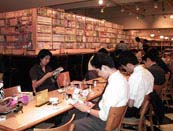|
Science & Technology || Sports & Fashion || Search || Back Numbers
THE FUTURE OF MANGA? Coffee Shop Reading Skyrockets in Popularity June 26, 1998  Customers enjoy a quiet read in a mange cafe.
Although there seems to be a trend among young people away from
buying comic magazines, or "manga," new cafes known as "manga
coffee shops" are springing up at a dramatic rate. These coffee
shops have collected volumes of manga available for customers
to read on the premises, and new shops have been opening in the
Tokyo area in the past year at a rate estimated to be two to three
times that of the previous year. This has led to speculation that
manga coffee shops may become an industry on a par with karaoke
clubs in the near future. Perhaps the popularity of manga among
young people has more staying power than has been thought. In Tokyo's Ikebukuro district, there is a shop run by a former office worker. Three years ago, when he was working for a major travel agency, he was given orders to transfer to another branch. He refused, however, saying that he had accumulated so many volumes of manga that his home was full to bursting, and he couldn't move. Thus, he decided to open a manga coffee shop instead. This is the sort of motivation for getting out of the rat race that might be found in a manga story. This shop has 12,000 volumes of manga on hand, including some rare volumes worth hundreds of dollars. The owner declares that 70% of the key to success in this business is the quality of the manga in the shop, and the other 30% is the level of customer comfort. According to industry experts, it was in 1997 that manga coffee
shops started experiencing explosive growth in Tokyo. They say
there are no less than 100 such shops in the city alone, and that
their vitality is showing no signs of slowing down. These publications all indicate the same reason for this decline. As the focus of young people's interest has broadened to encompass video games and cellular phones, a sluggish economy has reduced the amount of money they have to spend, and they are not buying comic magazines like they used to. This means that they go to manga coffee shops and read the stories they want to read in collected volumes, instead. The manga coffee shops, however, see their booming business in a different way: The more unpleasant a day is for an office worker--be it hot or cold, the Monday after a holiday, or the day before a payday--the better it is for their business. The shops are of the opinion that they offer a place to hide out, to get away from it all, in the midst of the concrete jungle that is Tokyo. In any event, within the industry itself there are ambitious predictions that manga coffee shops will soon become as much of a presence as karaoke clubs. Compared to karaoke, which has annual attendance figures of some 60 million people in 160,000 clubs, manga coffee shops do not occupy a very large slice of the entertainment-industry pie. But if the manga-reading public that makes up the 8-million-plus combined circulation of the seven weekly young-adult comic magazines turns its attention to manga coffee shops, those establishments could easily pass karaoke clubs. If these predictions are on the mark, then it is conceivable that, as the sight of young people reading manga on trains fades from view, the only coffee shops in shopping districts at all will be manga coffee shops. This may well herald the coming of yet another new and uniquely Japanese phenomenon.
 Edited by Japan Echo Inc. based on domestic Japanese news sources.
Articles presented here are offered for reference purposes and
do not necessarily represent the policy or views of the Japanese
Government. Edited by Japan Echo Inc. based on domestic Japanese news sources.
Articles presented here are offered for reference purposes and
do not necessarily represent the policy or views of the Japanese
Government.
|
